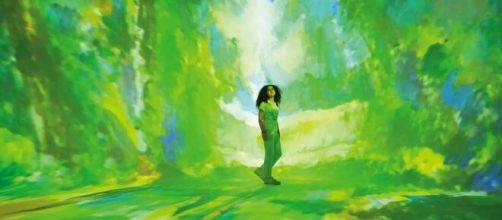Prepare yourselves. Here comes an “immersive art” show of a second kind, one that can weigh heavy not only on the eyes but also on the nervous system.
Fad Magazine reports a new 30,000-square-foot exhibit hall opening in London this autumn to permanently house multiple immersive art shows from Cezanne and Canaletto to Klimt and Kandinsky.
What is it?
But it’s the sensory experience of the Kandinsky show that is liable to overload one’s neurons. Unlike other immersive shows, this one is totally abstract. So, there’s nothing recognizable to ground you.
The sight of non-objective imagery flooding floors, ceilings, and walls – all in high-definition and high color – may feel crushing.
Jacking up easel paintings to a vastness never intended by the artist may be entertaining when it comes to viewing painters like, say, Monet and his water lilies or Van Gogh and his cypress trees.
But inundating an exhibit hall with gargantuan blow-ups of Kandinsky circles, streaks, and slashes of raw primary colors without anything familiar to fix on...well, let’s just say that you might not want to be caught in that maelstrom. You’re liable to feel dizzy.
Kandinsky himself had a mild form of that experience. It’s how he came upon the power of abstract painting.
It was in 1910 at his studio in Munich. He had just returned from a day of sketching. On opening the studio door, he saw a painting he didn’t recognize. “Bewildered,” he wrote down the incident this way: “I stopped, staring at it. The painting lacked all subject, depicted no identifiable object, and was entirely composed of bright color patches.
Finally, I approached closer and only then, recognized it for what it really was – my own painting, standing on its side on the easel.”
Birth of abstract painting
And that’s how abstract painting came into the world. Kandinsky is credited with being the first artist in the Western world to discover a visual art style that completely departed from the natural world.
After the Munich incident, he never wanted his pictures to be about anything in nature again. He said he sought to represent the forces behind nature – their energy.
He went about picturing energy using short strokes brushed in different directions to signal movement. He also used a dark outline to enclose his free-form picture parts with unmixed primary colors, which he then intensified by adding white throughout the picture.
Kandinsky came to believe that color creates a “corresponding vibration in the human soul,” Given that’s what he was trying for in his easel painting – to rattle your spiritual being – imagine what mountain-size magnifications could do to you.
He penned a whole treatise on the subject titled, “The Art of Spiritual Harmony,” arguing that the more abstract a form is, the more clear and direct is its appeal. Again, he was talking about easel painting, not painting bleeding out all over the place.


